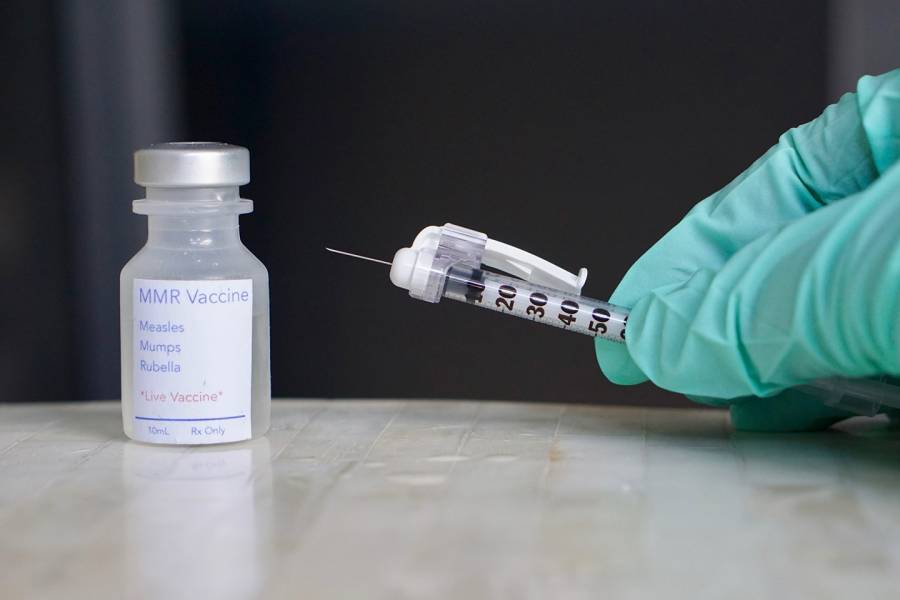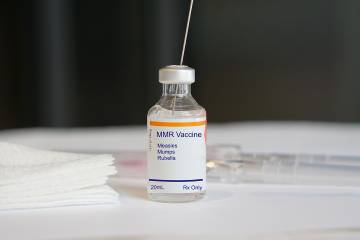- Name
- Robin Scullin
- rsculli@jhu.edu
- Office phone
- (410) 955-7619
- Name
- Barbara Benham
- bbenham1@jhu.edu
- Office phone
- (410) 614-6029
A country's progress toward measles elimination can be mapped on a "canonical path" that in turn can guide vaccination strategies, according to a study from scientists at the Johns Hopkins Bloomberg School of Public Health.
The researchers found that countries tend to follow a trajectory for eliminating measles that is driven by birth rate and vaccination coverage. Adoption of the new canonical path concept, described in a paper published today in Science, could help countries tailor measles control efforts as they progress towards measles elimination in general and could also serve as a guide for responding to measles outbreaks. The researchers call this path "canonical" because it is the expected outcome of the fundamental theory that governs epidemic dynamics for measles.
The researchers have developed a web application to show where countries lie on the path to measles elimination.
Measles infects several million people globally, mostly children, and kills an estimated 100,000 people every year. Even as late as 2000, when measles was declared eliminated in the U.S., there were as many as 28 million measles cases globally with more than 500,000 associated deaths. In recent years, there have been measles outbreaks with thousands of reported cases even in wealthy countries such as Germany, Italy and Spain. Some less-wealthy countries including India, the Philippines, Ethiopia and Nigeria still at times report tens of thousands of cases each year. The Centers for Disease Control and Prevention has estimated that between 2000-2017, measles vaccinations prevented more than 20 million deaths worldwide.
Recent outbreaks in the U.S. and across the globe are making 2019 one of the worst year for measles in decades.
"When we completed the initial analysis for this paper using data up until 2014, the story was very clear: Countries were progressing towards elimination along the canonical path then staying there," says study senior author Justin Lessler, associate professor in the Department of Epidemiology at the Bloomberg School. "Unfortunately, when we added more recent data, the story got more complicated as many countries, particularly in the Americas, began to move backward along the path, the result of inadequate vaccination fueled in part by social unrest and vaccine refusal in various countries."
Adds study co-first author Amy Winter, a postdoctoral researcher in the Department of Epidemiology: "There has been generally a reliance on crude and qualitative frameworks for ranking countries in their progress to elimination and determining vaccination strategies. We wanted to improve this framework using readily available data and simple calculations to summarize the complex dynamics as countries move to measles elimination."
The canonical path described by Winter, Lessler, and their colleagues reflects the fact that a country's annual number of measles cases per capita, a measure called the incidence, declines as the number of measles-susceptible people declines. The decline in the number of susceptible children occurs due to increased vaccination and/or drops in the birth rate. The path also reflects the observation that, as measles incidence declines, it initially becomes more variable from year to year—as susceptible hosts become fewer and farther apart on average, and outbreaks become more sporadic and unpredictable.
These more sporadic outbreaks change the nature of who gets infected, changing the disease from one that typically affects only children to one that can strike adults as well. This age shift has been obvious in recent outbreaks in the U.S. and elsewhere.
"Eventually you reach a point on the path where you really do appear to have measles under control and are moving towards elimination, and at that point the variability of the incidence starts to decrease too," Lessler says.
A country's position on this path implies other important information, such as the age distribution of the people who are susceptible to measles. As outbreaks become more sporadic, unvaccinated people can get older before they are infected. This can lead to challenges rarely seen in "endemic" settings where everyone gets infected in childhood, such as infections in pregnant women.
"Zambia, for example, went from having consistently widespread measles infections among young children to having almost no measles for a while, and then started having sporadic, occasionally large outbreaks in older children," Lessler says. "In cases like that, the age range you target with vaccination campaigns has to go up."
After introducing measles vaccines, countries generally tend to move along the path toward measles elimination. But if vaccination coverage is reduced, they can turn around and start moving in the opposite direction. For infectious disease epidemiologists, one of the big stories in the past few years has been the jump in measles cases in middle-income countries such as Brazil and Ukraine due in part to many parents' hesitancy in vaccinating their children.
"Since 2014 a number of countries have started moving backwards—they are seeing sporadic, large outbreaks." Lessler says. "The worry is that as vaccination rates decline, that backwards progression will continue."
Posted in Health
Tagged epidemiology, vaccines, infectious disease, measles











